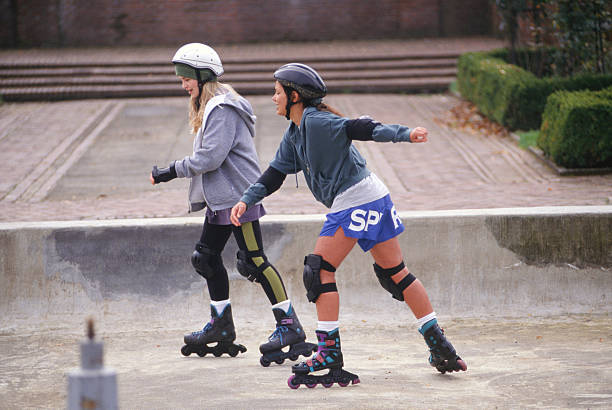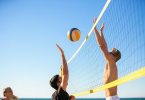Rollerblading is a great activity you can try on weekends or free days. If you are into weight loss, this is a good activity. But does rollerblading burn enough fat? How many calories does rollerblading burn? The simple answer is that rollerblading can burn between 350 to 600 calories per hour, depending on a person’s weight, intensity, and duration of the activity. Heavier individuals tend to burn more calories as they require more energy to move their bodies
However, you need to check out this article for information on how many calories rollerblading burns and its essential health benefits.
What is Rollerblading?
Rollerblading, also known as inline skating, is a popular form of exercise and recreational activity that involves gliding on a pair of inline skates. It has been around since the 1980s and has gained a massive following worldwide due to its many benefits.
Rollerblading is not only a fun way to stay active, but it also provides a full-body workout that can help improve cardiovascular health, strengthen muscles, and burn calories. People engage in rollerblading for various reasons, including weight loss, stress relief, and socializing with friends.
However, many people may be unaware of the number of calories burned while rollerblading, which can be a significant pain point for those looking to track their progress or achieve specific fitness goals.
That’s where this article comes in. In this article, we will explore how many calories are burned while rollerblading and factors that affect calorie burn.
How Many Calories Does Rollerblading Burn?
The number of calories burned while rollerblading can vary depending on several factors, including weight, activity intensity, duration, and metabolism. On average, rollerblading can burn approximately 350 to 600 calories per hour.
Harvard Health Publishing stated that a 155lbs weight person could burn around 350 calories during an hour of moderate rollerblading. A 155 lbs person can burn up to 480 calories in a more intense rollerblading activity.
It’s important to note that these numbers are estimates and can vary from person to person. If you want a more accurate estimation of the calories burned during rollerblading, consider using fitness trackers or apps that provide activity-specific calorie calculations based on your personal information.
Is rollerblading good for weight loss?
Yes, rollerblading can be a beneficial activity for weight loss. It is a form of aerobic exercise that can help you burn calories and increase your overall energy expenditure.
Rollerblading engages multiple muscle groups, including your legs, core, and glutes, which can contribute to increased muscle tone and improved cardiovascular fitness.
Regular rollerblading sessions and a balanced diet can create a calorie deficit necessary for weight loss.
To maximize the effectiveness of rollerblading for weight loss, you can vary the intensity of your workouts, increase the duration or frequency of your sessions, and incorporate interval training or uphill skating for an additional challenge.
Does rollerblading burn belly fat?
Like any exercise, rollerblading can contribute to weight loss, including reducing belly fat. When you engage in rollerblading, you burn calories. If you consistently maintain a calorie deficit, your body will utilize stored fat for energy, including the fat around your belly.
However, it’s important to note that spot reduction, explicitly targeting fat loss from a particular body area, is not possible through exercise alone. Your body determines where it stores and loses fat based on genetics and hormonal influences. So while rollerblading can reduce overall body fat, it does not specifically target belly fat.
To effectively reduce belly fat, it’s essential to focus on a combination of regular aerobic exercise, such as rollerblading, along with a healthy, balanced diet. Additionally, incorporating strength training exercises can help build muscle and increase your metabolism, which can further aid in fat loss.
Other Health Benefits Of Rollerblading
Rollerblading offers a range of health benefits beyond weight loss. Some of the additional health benefits of rollerblading include:
• Cardiovascular fitness
Rollerblading is an excellent aerobic exercise that gets your heart pumping, improving cardiovascular health and increasing stamina. This helps to reduce the risk of cardiovascular-related diseases.
• Increases muscle strength and endurance
Rollerblading primarily targets the muscles in your legs, including the quadriceps, hamstrings, glutes, and calves. Regular rollerblading can help strengthen and tone these muscles, improving overall lower body strength and endurance.
• Balance and coordination
Rollerblading requires balance and coordination to maintain gliding stability. Continued practice can enhance these skills and improve proprioception (awareness of body position), which can benefit overall motor skills and balance in everyday activities.
• Joint health and low impact
Rollerblading is a low-impact exercise that puts less stress on your joints than running or jumping. It can be suitable for individuals with joint issues who want to minimize impact while still getting a good workout.
• Core strengthening
While rollerblading, your core muscles stabilize your body and maintain balance. This helps strengthen your abdominal and back muscles, promoting better posture and stability.
• Promotes mental well-being
Rollerblading is a fun and enjoyable activity that can boost your mood and relieve stress. Outdoor rollerblading allows you to enjoy fresh air and nature, enhancing your mental well-being.
• Improved flexibility and range of motion
Regular rollerblading involves repetitive movements that can enhance flexibility and improve the range of motion in your hips, knees, and ankles.
Conclusion
As with any physical activity, it’s essential to start at a comfortable level, wear protective gear, and gradually increase intensity and duration as your fitness improves. Don’t rush to increase your intensity; you might strain your muscles. Going slowly and combining it with a healthy diet can help in proper weight loss.








